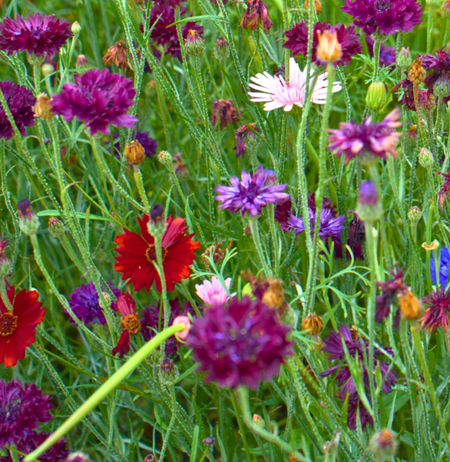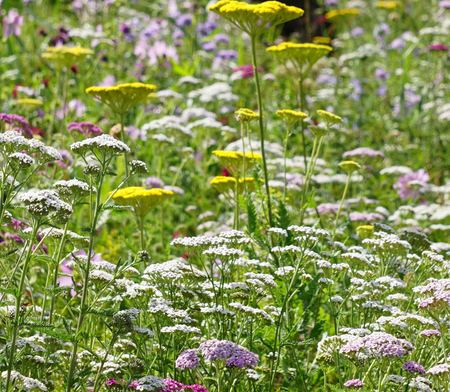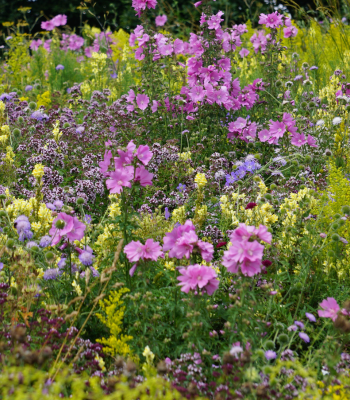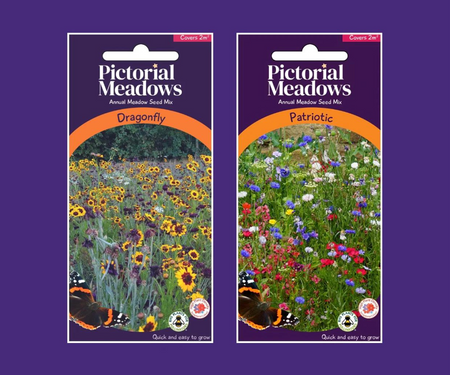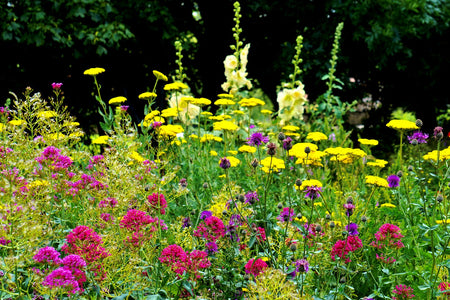Are annual meadows easy to grow, especially if I have little gardening experience?
Yes, annual meadows are easy to grow and are a great way for less confident gardeners to start with.
When is the best time to sow annual seeds?
The best month is April, but you can sow early in March if the ground feels workable and as late as early June.
Can I sow an annual meadow in the autumn?
Yes, but it is not advised if this is going to be your main display. Not all the annual seeds will survive in the ground over our cold and wet winters. However, some viable seeds of some species will survive and provide an earlier if different display.
Can I mix the annual seed with perennial seed?
No. If you are trying to establish a proper perennial meadow then do not put annual seeds with the mix. Annuals in the wrong amounts will very quickly out-compete the slower growing perennials and prevent many of them from establishing successfully.
Can I mix the annual seed with grass to make it go further?
No. Grass is very competitive and will quickly dominate the annual meadow plants and reduce the impact of the flowers.
What happens if I sow less or more than the recommended rate?
It’s best to stick to the 3g per square metre rule for annuals as that’s how we’ve formulated the meadow designs. 3 grams gives a good display on most soil types. Increasing the sowing rate will often mean more interspecies competition, which results in less diverse meadows dominated by just a few species. Decreasing the rate, especially below 2g, will make the meadow look very sparse to start with and encourage more weed invasion.
If I’ve sown an annual meadow one year, will it regrow the next year?
No, not really. Many species won’t reseed at all. Some species will, but in a much more random and patchy way. However, if you have fairly infertile soil or you have experienced very little weed infestation, you can get some lovely second and third-year displays taking place from the few species that do reseed.
Do I need to protect the seed from birds, mice, or squirrels?
Only very rarely. We have sown hundreds of meadows in areas that have never shown any predation by birds or other animals, but that doesn’t mean it can’t ever happen.
What effect will the fertility of my soil have on the display?
Annual meadows thrive on normal to high fertility soils, making them the perfect meadow solution for most gardens and parks. The richer the soil though, the taller and bushier the plants will be. The thinner and poorer the soil, the opposite will happen. Normally, if you grow annual meadows on the same patch of ground for more than three years, you will see the fertility start to decrease and the emerging meadows look finer and shorter. This is a perfect time to think about moving onto establishing a perennial meadow, which does best on lower fertility soils.
My display has been looking great, but in the recent hot and dry weather it is starting to go over. Is there anything I can do?
Most years, the displays carry on with later, taller flowers masking the shorter, earlier ones. Sometimes it’s just a question of giving nature a little bit more time. Even if the later flowers are less showy, they will still have a lot of sparkle. If they’re looking more brown than colourful, you can give them the ‘Chelsea chop,’ which is a very high cut to knock off the seeding flower heads and stimulate a second flush of greener growth and flowers.
It looks like I just have a blanket of weeds, is there anything I can do?
Unfortunately this sometimes happens if there is a big weed seed bank in your soil, but don’t panic. Wait until your weeds are about 150mm (6 inches) tall and run your mower over the whole area on the highest cut. This checks the weeds and allows the slower growing meadow seedlings to come through.
Do I need to irrigate my annual meadow?
No, but it’s important to roll or firm the seeds into the ground so the seedlings get enough moisture. The seeds will germinate readily as soon as the soil is warm and moist enough. The only time an annual meadow might need irrigation is if it must be in flower for a particular date and the weather has turned exceptionally dry and hot. In these circumstances, a couple of good soakings will help things along, but stop as soon as seedlings have created a green cover over the soil.
Does the sowing time impact the length of the flowering time?
Every year is different. In general, early sowings will mean your meadow will come into flower earlier. If the summer is very hot and dry, they may finish earlier.
How early and how late can I safely sow annual seeds?
The best month is April, but you can sow early in March if the ground feels workable and as late as early June.
Can I sow my seeds over existing grass?
No, grass will prevent your seeds from growing. You need to prepare a very clean, weed-free seed bed.
Are there any grasses in your annual mixes?
No, we don’t add any grasses to our annual mixes.
What do I need to do if I want to resow with an annual mix for a second or follow-on year?
You must start from scratch each spring by cutting down any old growth and creating a clean, cultivated seed bed again. You will find that both weeds and a few self-seeded annuals will start to build up in the seed bed over time.
Which mix is best for clay soil?
All our annual mixes will grow well on clay soils.
Do I need to worry about slugs and snails eating my annual meadow seedlings?
Very occasionally, slugs have been known to graze young, emerging annual meadow sowings.
Do you ship worldwide?
No, but you can purchase the Pictorial Meadows seed mixes through our European agents Florum DK and Bloomingfields.

